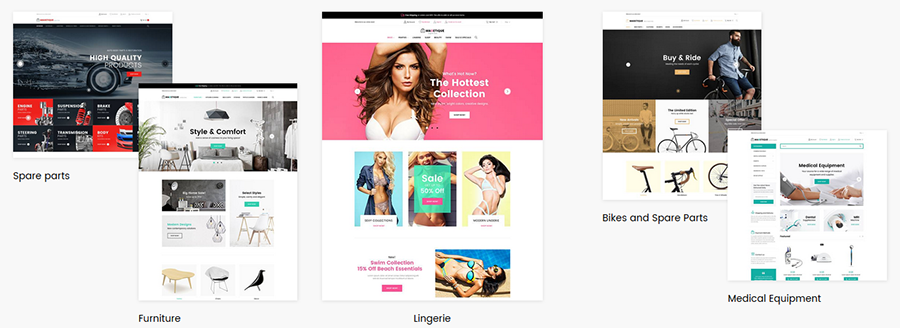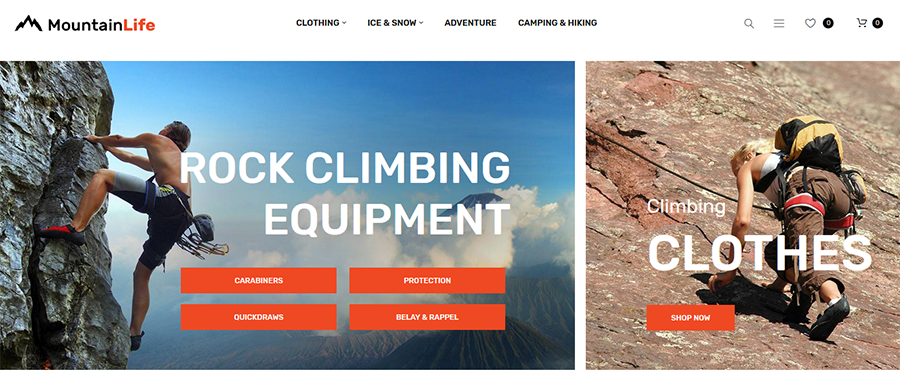The BEST Way to Start a Magento Project
Whether you are new to Magento and just want to have some basic knowledge about it or already have some experience with it, there is a number of aspects that you need to consider before launching a Magento project.
In the following, we will go through these points and give you some help in choosing the best way you should take to reach your goal:
- Make the decision: Magento 1 or Magento 2
- Pre-built theme vs. custom design
- Top Magento 2 Themes
- Matching business needs: features that can or cannot be implemented via a theme and extensions
- Integration to external systems
- How to pick a developer? Freelancer or agency?
- What you should ask your potential developer
- Criteria for choosing a hosting solution for your Magento store
What to choose: Magento 1 or Magento 2?
Magento is one of the most popular ecommerce platforms in the world. Over 250,000 online stores have been built on this system since its launch in 2008.
Magento’s unmatched strength lies in its customizability: you can create any kind of ecommerce store you wish, both in terms of front-end and back-end features. And probably that’s why you’re now considering having a Magento store in the first place.
Go for Magento 2
If you want to have a new Magento store, forget about Magento 1. Although there is a good number of developers out there who could create a perfectly working, custom Magento 1.x store for you, the future is all about Magento 2.
Magento has improved in many ways, thus, with Magento 2, now you can enjoy:
- Better performance
- Streamlined checkout
- Easier updating
- Simpler navigation
- Ajax add-to-cart solution
- Scalability
- Simpler navigation
- Improved dashboard
- Simpler product upload
- More efficient testing
So, you can see that having your store developed in Magento 2 is the logical choice.

Pre-built theme or custom design?
It’s very tempting to create a storefront that is unique in every little detail. But don’t fall too early in love with the possibility of having a fully customized store design.
Be smart. Give thought to some aspects that finally help you make a good choice.
Costs
Having a fully customized frontend in Magento is not cheap. You need to hire a web designer and a front-end developer to create the appearance you desire. It takes many working hours (100-200 on average), which boils down to approx. $10,000-$20,000.
A readily available, standard, single site license Magento 2 theme costs around $100-$200.
Timing
Development doesn’t go fast. In fact, it probably takes longer than you’d expect. Even if everything is scheduled beforehand, oftentimes, due to unforeseen obstacles or extra needs, the process is prolonged and can easily amount to several months.
You can install your downloaded template right away. Although, you will most likely need an expert’s assistance here.
Matching business needs
Although using a downloadable template is much cheaper and faster, it may lack some important visual and functional elements or features you would need. You also have the opportunity to develop further the purchased theme with the help of a Magento developer, so that you can have the extras you missed originally.
A fully customized storefront can still be a wise solution if you have special branding, corporate identity, or other custom business needs. It may well worth it for a larger company, for example, to have a totally customized storefront in order to offer an unmatched user experience in their market niche.
Top Magento 2 themes
Which industry are you in? Fashion, sports, food, or electronics? Themes are mostly developed for different business types so you’ll probably find a nice-looking theme matching your own expectations.
You can find over 70 Magento 2 themes in various categories at Template Monster. For example, if you deal with cars, you are offered 4 special templates in that category.
You can also filter your search down to “Best Sellers” to see which templates are the most popular at the moment. As we can see, there is a number state-of-the-art, fully responsive ecommerce templates in a number of categories, but there are some multipurpose themes as well, like Magetique.

It offers 5 layouts for different niches, you can manage colors, change header and footer layouts, and also use built-in Magento extensions, such as Ajax Search, Blog, or Social Sharing, just to name a few.
If you are into home, décor, or lighting, Lightedix may be a good choice. It features a clean and simple layout format. Some useful modules are also included like Newsletter Popup, Featured Products, or Mega Menu with which you can create customized menus showing categories, subcategories, and posts.

To achieve a visually dramatic and appealing appearance, you may use the MountainLife theme. Large sized images dominate the main page to which you can add your category titles or main messages. This is a very simple, yet powerful storefront that works nicely both on mobile devices and desktops.

It’s good to know that you can choose additional services when buying templates from Template Monster. For example, you can request installation or web hosting services at an extra cost.
However, if you need more specialized services, (e.g. ERP integration or adding custom extensions), you’ll need a Magento developer or even a dedicated team to make everything work fine.
Free Ways To Grow Your Website: $0 Budget Ideas [Free eBook]
Do you have extra needs? – Features that can or cannot be implemented via a theme and extensions
When measuring up your business needs, it’s useful to make a list of the features that you want to have in your store.
Your chosen theme may not have all these, but you can purchase extensions to expand your store’s functionality. There is an increasing number of Magento 2 extensions available (over 1,000 at Magento Marketplace) in several categories, e.g. Marketing, Sales, Accounting, Site Optimization, Payments, etc.).
It may take some time to find the right solutions to meet your requirements or you can ask an expert to recommend and install such modules.
Also, you can have your own extension developed if you cannot find a proper solution to your specific ecommerce challenge.
Integration to external systems
In many cases a merchant would like to connect an ERP (enterprise resource planning) or any third-party system to the online store. These are typically accounting, customer management, and inventory solutions that handle and gather a huge amount of data which are required to pass back and forth the two systems.
It’s important to note that, in general, integrations are difficult processes to carry out. Here you want to connect two systems built on different code bases and there are many variables which can easily make the whole process very complicated and time-consuming.
Although the most popular ERP platforms already have a prebuilt connector for Magento, implementing and operating them properly may still be challenging.
For all these reasons, it’s crucial to find reliable, experienced Magento ERP integration specialists in this field who can seamlessly complete an integration project.
How to pick a developer? Should I hire a freelancer or an agency?
When the need arises for hiring a developer, you probably ask the questions above.
There are many Magento developers out there, but it’s not at all easy to find the ones that can serve you best.
A crucial question is whether to work with a freelancer or a development agency.
There are several pros and cons for both:
| Freelancer Pros | Freelancer Cons | Agency Pros | Agency Cons |
| Lower costs | Availability risk (e.g. developer is on holiday) | Availability (all year round) | Higher price |
| Flexible | Limited / focused expertise | Broader expertise, teamwork | Less flexible |
| Faster work | Slower (in urgent cases) | Complex / urgent tasks to be solved efficiently (project management, business analysis, and software architect services) | Simple tasks may take more time to perform |
| Direct contact (faster, effective communication) | Ongoing support | Indirect contact (slower and less precise communication) |
Pricing of Magento projects can vary substantially depending on the developer “type” (freelancer vs. agency), geographical region (e.g. Eastern Europe vs. North America), and other aspects, such as complexity, urgency, or “quality” of the project.
Consequently, don’t be surprised if you get a quote from an Indian freelancer of $10,000 and one of 80,000 from a US ecommerce development agency for the same project.
Questions you should ask your future developer
Prior to making a decision, you should examine some critical aspects that will help you shorten the list of potential developers.
Along with setting a budget and requesting a quote for your Magento project, it’s worth asking some questions so you’ll have valuable information about the experience, reliability, and quality you are offered and see if the provider can meet your expectations.
What kind of references do you have?
The developers’ portfolio shows you immediately if they have the relevant experience.
How long have you been developing in Magento 2?
Coding in Magento 2 is a lot different from coding in Magento 1. So you should know exactly what kind of Magento 2 projects they have completed and since when they have been dealing with Magento 2 (it was released in 2015).
What kind of support will you provide? Do you provide project management, UX, IT, and general Magento consultancy?
There is no development without errors. You will also need help if you want to make further changes. Magento is quite complex to deal with, therefore, in most cases, some kind of support is needed. You have to know beforehand what kind of help and services you can expect after your store is created.
Do you have a quality assurance process?
The developers should take responsibility for all developments they carry out. This usually includes both automated and manual testing to reveal bugs. You have to make sure that your developers will deliver a fully functional store.
Will you teach me how to use the platform?
Magento is not very easy to handle. It has loads of functions that take a considerable amount of time to learn. If someone teaches you how to use them, it can save you a lot of time.
Do you provide hosting services?
It can be an advantage if the developer and hosting teams are under one roof. Magento hosting can be complex at times and having the developers “at hand” helps communication and problem-solving processes faster and more effective.
Basics you need to know about Magento hosting
Hosting plays a crucial role in a Magento project.
In simple terms, hosting can make or break your ecommerce store’s success: page speed (which influences Google positions and user experience), load optimization, and security all depend on the quality of the hosting service.
Before you choose a hosting service provider, make sure it can deliver top quality.
These criteria will help you make an assessment:
- Service availability: The higher the better; a 99.90%–99.99% uptime is excellent.
- Scalability: The best way to optimize resources and performance is to scale up server capacity when your website’s traffic increases and scale down when it decreases. Ideally it is done automatically and you pay for only the capacities that you actually use.
- Pricing policy: You should only pay for the service that you actually use. If upfront costs seem too high, ask the provider about the reasons for that.
- Speed: The closer the servers are located geographically, the faster your website can load on the users’ devices. A content delivery network (CDN) is an optimal solution, provided by a good number of trustworthy companies.
- Security: Make sure the hosting provider has all the necessary official certificates and licenses and also study the SLA carefully so you will know about the conditions of storing and accessing your data, disaster recovery, backups, etc.
Summary
Magento is probably the best online store platform if you’re looking for a fully customizable, smart, and sophisticated ecommerce solution. But you need to make several decisions at the beginning so that you can be sure you choose the right path to success.
If you’re about to start a Magento project, it’s well worth taking the time to:
- Define your business goals and needs
- Allocate a budget for creating your Magento store
- Go through and give a deeper thought to all the points mentioned in this article
- Gather further information needed for decision-making
- Make a plan, including deadlines, how you will carry out your project step by step
Related Posts
List of Top Blog Extensions for Magento
10 Striking Fashion Designer Magento Themes in 2017
21 Great Responsive Magento Themes
Top Most Popular and Customizable WordPress and Magento Themes Of 2017
Don’t miss out these all-time favourites
- The best hosting for a WordPress website. Tap our link to get the best price on the market with 82% off. If HostPapa didn’t impress you check out other alternatives.
- Website Installation service - to get your template up and running within just 6 hours without hassle. No minute is wasted and the work is going.
- ONE Membership - to download unlimited number of WordPress themes, plugins, ppt and other products within one license. Since bigger is always better.
- Ready-to-Use Website service is the ultimate solution that includes full template installation & configuration, content integration, implementation of must-have plugins, security features and Extended on-page SEO optimization. A team of developers will do all the work for you.
- Must-Have WordPress Plugins - to get the most essential plugins for your website in one bundle. All plugins will be installed, activated and checked for proper functioning.
- Finest Stock Images for Websites - to create amazing visuals. You’ll get access to Depositphotos.com to choose 15 images with unlimited topic and size selection.
- SSL Certificate Creation service - to get the absolute trust of your website visitors. Comodo Certificate is the most reliable https protocol that ensures users data safety against cyber attacks.
- Website speed optimization service - to increase UX of your site and get a better Google PageSpeed score.
Get more to your email
Subscribe to our newsletter and access exclusive content and offers available only to MonsterPost subscribers.

Leave a Reply
You must be logged in to post a comment.